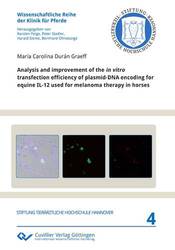| Departments | |
|---|---|
| Book Series (96) |
1378
|
| Nachhaltigkeit |
3
|
| Gesundheitswesen |
1
|
| Humanities |
2365
|
| Natural Sciences |
5406
|
| Mathematics | 229 |
| Informatics | 319 |
| Physics | 980 |
| Chemistry | 1363 |
| Geosciences | 131 |
| Human medicine | 243 |
| Stomatology | 10 |
| Veterinary medicine | 108 |
| Pharmacy | 147 |
| Biology | 835 |
| Biochemistry, molecular biology, gene technology | 121 |
| Biophysics | 25 |
| Domestic and nutritional science | 45 |
| Agricultural science | 1004 |
| Forest science | 201 |
| Horticultural science | 20 |
| Environmental research, ecology and landscape conservation | 148 |
| Engineering |
1793
|
| Common |
98
|
|
Leitlinien Unfallchirurgie
5. Auflage bestellen |
|
Advanced Search
Analysis and improvement of the in vitro transfection efficiency of plasmid-DNA encoding for equine IL-12 used for melanoma therapy in horses (Volume 4) (English shop)
María Carolina Durán Graeff (Author)Preview
Extract, PDF (67 KB)
Table of Contents, PDF (15 KB)
In horses studies targeting equine melanoma therapy using DNA encoding for cytokines as interleukin 12 (IL-12) have shown some promising results. Nevertheless, complete remission after treatment has been only observed in few cases, possibly due to reduced therapy efficiency. Herein transfection efficiency and methodology-induced cytotoxicity were analysed after transfection with different nanoparticle-mediated and conventional approaches using eukaryotic DNA-expression-plasmids and mammalian cell lines. The addition of gold nanoparticles (AuNPs) to the transfection protocols significantly increased transfection efficiency when compared to a conventional FHD mediated transfection protocol, and cell vitality was mainly negatively affected by the addition of chemically generated AuNPs. To measure accurately equine IL-12 and IFN-gamma concentrations after therapy, several antibodies for cross reactivity against this equine cytokines were evaluated, establishing afterwards a bead-based Luminex assay. Additionally, considering the valuable characteristics of dendritic cells (DCs), their use in further equine melanoma studies could be beneficial. To improve the still poor generation efficiency in horses, a human CD14 monoclonal antibody and an automated magnetic activated cell sorting system was used, reaching 2-fold higher DC yields than in previous published outcomes.
| ISBN-13 (Hard Copy) | 9783954042845 |
| ISBN-13 (eBook) | 9783736942844 |
| Final Book Format | A5 |
| Language | English |
| Page Number | 146 |
| Lamination of Cover | matt |
| Edition | 1. Aufl. |
| Book Series | Wissenschaftliche Reihe der Klinik für Pferde |
| Volume | 4 |
| Publication Place | Göttingen |
| Place of Dissertation | Hannover |
| Publication Date | 2012-11-22 |
| General Categorization | Dissertation |
| Departments |
Veterinary medicine
|
| Keywords | Allgemeine Veterinärmedizin, Spezielle Veterinärmedizin, Equine Melanoma, IL-12, transfection efficiency, IFN-gamma, Dendritic Cells |








